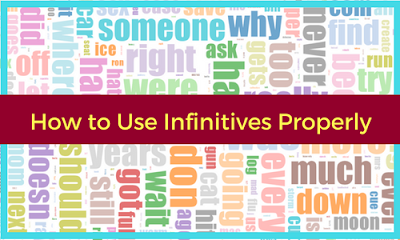
Infinitives
There are two types of infinitives in English language:Infinitive with to/ to infinitive:
Infinitives are used for the real, abstract and future actions. An infinitive that takes to before it is called infinitive with to.
We use infinitives in both active and passive form: Generally, students think that if we have infinitive with to in a sentence, we will use only 1st form of verb while we must know this rule to use the suitable verb with it.
- Active form of infinitive: to+ verb 1st form
- Passive form of infinitive: to be + verb 3rd form
Rules for infinitives
1. We use infinitive with to as a subject of any verb:
- To find fault is easy. (√)
- To walk is a good exercise. (√)
- To get up late in the morning is not good for health. (√)
This is a very common way that infinitives are used
- He refused obey his father. (×) , He refused to obey his father. (√)
- The teacher always encourages the students work hard. (×), The teacher always encourages the students to work hard. (√)
Ex:
- His desire is to see Justin again. (√)
- My aim is to become a bank P.O. (√)
Sometimes we use infinitive with to as an object of preposition.
Ex:
- Mr. Sharma wants nothing but buy a car. (×) , Mr. Sharma wants nothing but to buy a car. (√)
- He wants nothing but play cricket. (×) , He wants nothing but to play cricket. (√)
Allow, advice, expect, encourage, forbid, force, tell, want, warn, teach, show, remind, invite, order, permit after these verbs we use object + infinitive with to instead of that. Because sometimes we can see our sentence with (that) instead of (to) in our sentence.
Ex:
- She taught her daughter that she should come at home on time. (×) , She taught her daughter to come at home on time. (√)
- He allowed his son that he can enter the room. (×) , He allowed his son to enter the room. (√)
- He promises that he will get a good result. (×) , He promises to get a good result. (√)
Able, unable, glad, happy, angry, fit, stupid, wrong, right, lucky, disappointed after these adjectives we use infinitive with to.
Ex:
- He is not able for this work. (×) , He is unable to do this work. (√)
- She is surprised see you here. (×) , She is surprised to see you here. (√)
- It makes me angry waiting for you. (×) , It makes me angry to wait for you. (√)
There are some nouns that take infinitive with to and these nouns are wish, decision, need, pleasure etc.
Ex:
- It is pleasure see them again. (×) , It is pleasure to see them again. (√)
- I have decided that I’ll go there. (×) , I have decided to go there. (√)
When infinitive with to use for qualifying noun, verb, adjective or any sentence it is called gerundial or qualifying infinitive. That’s why sentence looks correct in the gerund form but actually the sentence does not correct.
Ex:
- Making castles in the air. (×) , To make, castles in the air. (√)
- Killing two birds with one stone. (×) , To kill, two birds with one stone. (√)
Infinitive without to:
1. We can’t use infinitive with to with model auxiliary verbs:
Sometimes we can see some auxiliary verbs i.e. can, could, may, might, shall, should, will, would, must in a sentence so we need to remove to from that sentence to correct that sentence.
- You can to go there. (×) , You can go there. (√)
- It may to rain today. (×) , It may rain today. (√)
- He can to play Hockey. (×) , He can play Hockey. (√)
- Let me to go there. (×) , Let me go there. (√)
- Let us to go to the park. (×) , Let us go to the park. (√)
- They made me to laugh. (×) , They made me laugh. (√)
- I was made laugh. (×) , I was made to laugh. (√)
Had better, had sooner, had rather, would rather, would sooner after these words we can’t use infinitive with to
Ex:
- You had better to stop taking medicine which has harmful side-effects. (×), You had better stop taking medicine which has harmful side-effects. (√)
- You had better come now. (×) , You had better to come now. (√)
If we have these verbs Feel, hear, see, notice, watch + obj. in a sentence we can’t use infinitive with to
Ex:
- He heard her to laugh. (×) , He heard her laugh. (√)
- He watched the movie to enjoy. (×) , He watched the movie enjoy. (√)
If we have do, does and did before but or except we can’t infinitive with to
Ex:
- He did nothing but to laugh. (×)
- He did nothing but laugh. (√)
- He does nothing but to play. (×)
- He does nothing but play. (√)


